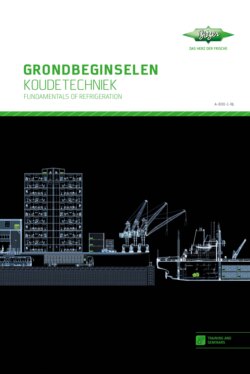Читать книгу GRONDBEGINSELEN KOUDETECHNIEK / In twee talen Nederlands/Engels - Volker Stamer - Страница 10
На сайте Литреса книга снята с продажи.
Оглавление1.
Grondbeginselen thermodynamica
1.1
Inleiding
Koudetechniek is een deelgebied van de warmteleer
(thermodynamica) dat zich bezighoudt met het gedrag
van vaste, vloeibare en gasvormige stoffen.
Thermo (Grieks) = Warmte
Dynamica (Grieks) = Leer der bewegings-
verschijnselen
Thermodynamica houdt zich dus bezig met „warmte-
bewegingen“ (aanvoer en verspreiding van warmte).
Strikt genomen bestaat de term „koude“ niet in de
thermodynamica, omdat kou alleen ontstaat door het
feit dat warmte wordt getransporteerd van de ene
plaats, waar hij ongewenst is, naar een andere.
Daarbij heeft een afgekoelde ruimte, stof of lichaam
nog een warmte-inhoud zolang de temperatuur hoger
is dan -273,15°C (het absolute nulpunt).
1.2
Temperatur
De temperatuur van een stof kan worden beschouwd
als een maataanduiding voor de intensiteit van de
bewegingen van de bouwstenen van materie (atomen,
moleculen en moleculaire groepen, zie ook fig. 1).
Fig. 1 Atoommodel van een vast lichaam
Atomic model of a solid body [TWK]
Bij vaste lichamen oscilleren de roosters rond een
vast punt. Wanneer deze beweging als gevolg van de
warmteafgifte zo sterk wordt, dat de roosterkrachten
worden overwonnen, stort het starre geheel in.
Het lichaam begint te smelten en wordt vloeibaar.
1.
Fundamentals of thermodynamics
1.1
Introduction
Refrigeration is a subfield of thermodynamics, which
deals with the behaviour of solid, liquid and gaseous
substances.
‘thermo’ (Greek): heat
‘dynamics’ (Greek): the science of movement
Thermodynamics therefore deals with ‘heat move-
ments’ (the supply and dissipation of heat).
Strictly speaking, the term ‘cold’ does not exist in
thermodynamics, because ‘cold’ arises only from
the fact that heat is transported from a place where
it is undesirable to a different location. However,
the cooled space, substance or body still retains
heat content, assuming the temperature is above
–273.15°C (absolute zero point).
1.2
Temperature
The temperature of a substance can be regarded as
a measure of the intensity of movement of the material
components (atoms, molecules and molecule groups,
also see Fig. 1).
In solid bodies, the lattice elements oscillate around
a centre point. If this movement becomes so strong,
due to heat input, that the lattice forces are over-
come, the rigid lattice collapses. The body begins to
melt and is then a liquid. However, cohesive forces
Grondbeginselen thermodynamica // Fundamentals of thermodynamics
12
